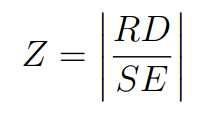Introduction
The Risk Difference (RD), also known as the Absolute Risk Reduction (ARR) or Absolute Risk Difference, is a measure used in epidemiology and clinical research to quantify the absolute difference in the risk of an event occurring between two groups. It is a straightforward and intuitive way to express the impact of an intervention or exposure on the occurrence of a specific outcome.
The risk difference is calculated using the following formula:
RD = Risk in Group 1 − Risk in Group 2
In the context of a clinical trial or observational study, "Group 1" and "Group 2" could represent two different treatment groups, intervention groups, or exposure categories. The "risk" refers to the probability of a particular event or outcome occurring within each group.
Key components of the risk difference formula include:
- Risk in Group 1: The proportion or percentage of individuals in Group 1 who experience the event of interest.
- Risk in Group 2: The proportion or percentage of individuals in Group 2 who experience the same event.
A positive risk difference indicates that the event is more likely to occur in Group 1, while a negative risk difference suggests a higher likelihood in Group 2.
Interpretation:
- Positive RD: Indicates that the intervention or exposure in Group 1 is associated with a higher absolute risk of the event compared to Group 2.
- Negative RD: Suggests that the intervention or exposure in Group 2 is associated with a higher absolute risk reduction, meaning a lower risk of the event compared to Group 1.
Example:
Consider a clinical trial comparing a new medication (Group 1) to a placebo (Group 2) for preventing heart attacks. If the event is a heart attack, a positive risk difference might mean that the medication is associated with an increased absolute risk of heart attacks compared to the placebo. Conversely, a negative risk difference would suggest that the medication is associated with a reduction in the absolute risk of heart attacks.
This article introduces a web-based calculator designed to determine the unadjusted risk difference along with confidence interval bounds, a Z-score, and a p-value.
Variables Definitions
- Event 1: The number of events in Group 1.
- Total 1: The total number of participants in Group 1.
- Event 2: The number of events in Group 2.
- Total 2: The total number of participants in Group 2.
- Confidence Level: The desired confidence level for the calculation, often chosen as 90%, 95%, or 99%.
Calculation Formulas
The Unadjusted Risk Difference (RD) is calculated using the formula:
Additionally, the calculator provides other statistical measures:
Where erf is the error of function implementation




